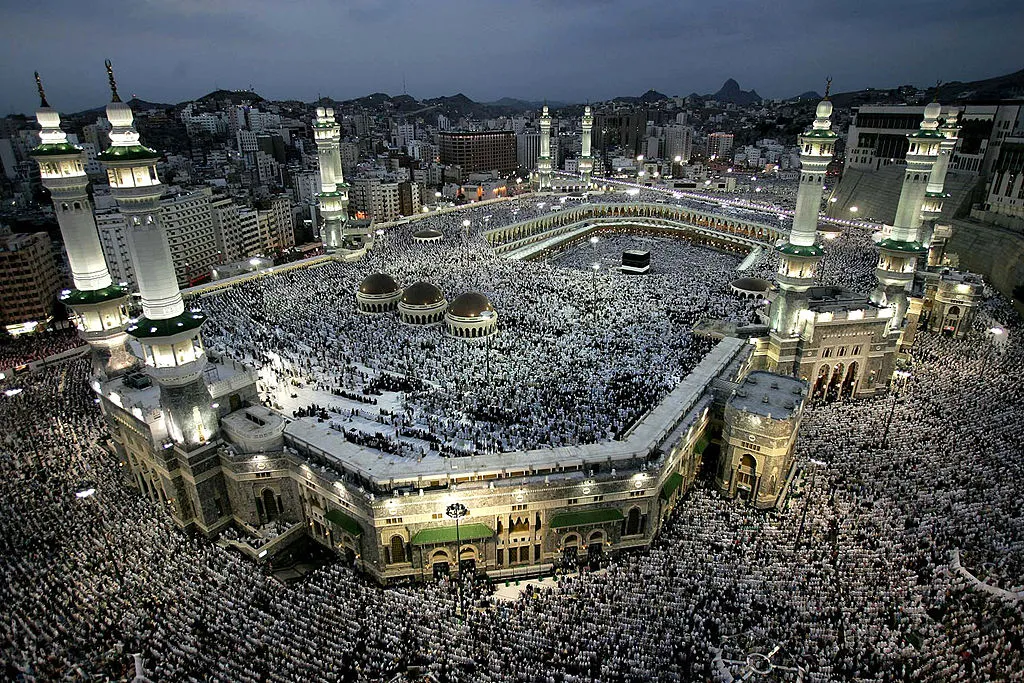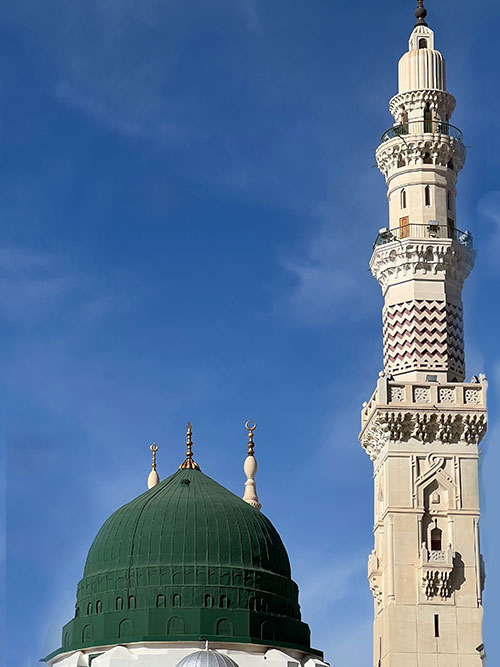The Kaaba is a sacred place of worship, where every corner holds a special significance, with numerous requests for worship made at these locations. In this article we introduce you Kaaba and its significance.
One of these special and sacred places for worship, where it is said that prayers, needs, and supplications hold great virtue, is the Hijr Ismail, where according to narrations, several prophets are buried.
In this regard, we intend to introduce the secrets of Hijr Ismail today and also to introduce the prophets who are buried in this place, so stay with us.

Where is the Kaaba? Kaaba and its significance
The Kaaba is the holiest place in Islam and among Muslims, serving as the direction for worship and prayers for the followers of Islam. The name Kaaba refers to its cubical structure.
In the Quran, it is mentioned about the construction of the Kaaba by one of the prophets of God named Prophet Abraham and his son Ismail. However, some believe that the House of God was built before Abraham, and the first builder was Prophet Adam.
The Kaaba is located in the Masjid al-Haram, where all Muslims worldwide stand facing the Kaaba five times a day during prayers.

7 interesting Places to visit in Jeddah
To understand the Kaaba and its significance, one should keep in mind that, this sacred place has many mysteries and symbols, which cannot all be expressed. One of the questions raised is whether any divine prophets are buried in the Masjid al-Haram and around the Kaaba, and how many divine prophets have been laid to rest in this place?
According to narrations, the construction of the Kaaba was carried out by Prophet Adam, and Prophet Abraham raised its foundations. All Muslims worldwide stand facing the Kaaba five times a day during prayers and perform Tawaf around it.
Where is the Stone of Ismail? Kaaba and its significance
“Stone of Ismail” ( Hijr Ismail) is a space located between the Kaaba and a semi-circular wall called the “Hateem” (measuring 1.5 meters in width and 90 centimeters in height), which extends from the Iraqi corner to the Syrian corner. Hijr Ismail is another aspect of Kaaba and its significance.
According to Islamic belief, stone of Ismail is a remnant from the time of Abraham and Ishmael and dates back to a period after the construction of the Kaaba. Its history and origin trace back to the time of the construction of the Kaaba by Abraham.
Historical accounts from Muslim historians narrate that Ishmael and his mother Hagar lived in this area.
It is quoted from Ja’far al-Sadiq: “Hijr is the house of Ishmael and the burial place of Hagar and Ishmael.” This statement is also mentioned in other sources.
Since stone Ismail is located inside the circuit of Tawaf, it can be considered as a symbol of its greatness. In essence, stone of Ismail is part of the Kaaba. When rain falls on the roof of the Kaaba, it pours down from the mercy spout into this space.
It is said that for the first time, during the reign of Mansur Abbasi, stone of Ismail was covered with white stones. After that, during the Abbasid era of Mahdi and also Harun al-Rashid, these stones were replaced and renewed.

Where is the “Meesab Rahmah”? Kaaba and its significance
The “Meesab Rahmah” (also known as the “Golden gutter“) is a golden spout installed on the roof of the Kaaba and directed towards the Hijr Ismail. When rain falls on the roof of the Kaaba, water pours from the spout into the space of Hijr Ismail. According to Muslims, this is the burial place of Ishmael, his mother Hagar, and many prophets.
It is said that Hajjaj ibn Yusuf Thaqafi first installed it so that rainwater wouldn’t accumulate on the roof of the house. It is narrated that prayers under the Meesab Rahmah are accepted.
A narration from the Prophet of Islam (peace be upon him and his family) states: “No one prays under the Meesab except that his prayer is answered,” indicating the acceptance and fulfillment of prayers made under the spout.

How many divine prophets are buried around the Kaaba?
The Kaaba, this sacred place, has many mysteries and secrets that cannot all be explained. One of the questions raised is whether any divine prophets are buried in the Masjid al-Haram and around the Kaaba and how many divine prophets have been laid to rest in this place?
According to historical accounts and narrations, numerous divine prophets are buried around the revered Kaaba, but the exact number is not accurately defined, and there are various narrations. The prophet being burried around Kaaba shows another aspect of Kaaba and its significance.
One of the areas around the House of God that holds greater virtue is a space called Hijr Ismail, an area between the Iraqi corner and the western corner of the Kaaba. It is believed to be the burial place of Hagar and Ishmael, and today, it is marked by a semi-circular structure. Pilgrims also perform Tawaf around it during their going-around, unable to enter this semi-circular area and space.
Hijr Ismail is considered by Muslims as a remnant from the time of Abraham and Ishmael and the burial place of the noble lady Hagar. After the passing of Hagar and her burial in this location, due to people stepping on her grave, Ishmael out of respect built a wall over his mother’s grave, allowing people to perform Tawaf at a greater distance from the House of God and refrain from stepping on his mother’s grave.
Historical accounts from Muslim historians narrate that Ishmael and his mother Hagar lived in this area. It is quoted from Imam al-Sadiq (peace be upon him): “Hijr is the house of Ishmael and the burial place of Hagar and Ishmael.”

Kaaba and its significance
As for the number of divine prophets buried around the House of God, it may not be possible to provide an exact figure since it has not been precisely mentioned. However, for example, according to a narration in Bihar al-Anwar, “From the Yemeni corner to the Black Stone, alongside the House of God, seventy divine prophets and messengers are buried.” Also, according to another narration from the same book, “Within Hijr Ismail, the semi-circular area currently present, under the golden spout of the House of God, seventy other divine prophets, including Ishmael, his daughters, and Hagar, are buried.”
According to a narration from Waqidi, a Sunni scholar, “From the Black Stone to the Zamzam well and the Maqam Ibrahim and Hijr Ismail, ninety-nine divine prophets are buried.” In another narration, it is stated that Prophet Jacob (peace be upon him), the venerable father of Prophet Joseph (peace be upon him), is buried opposite the Kaaba gate in the Hateem area.
Also, according to Sunni narrations, most of the prophets of Bani Israel are buried around the house of God, so it is clear that this holy place is full of graves and pure bodies of divine prophets.
Black Stone: Kaaba and its significance
The Black Stone (Al-Hajar Al-Aswad) holds a revered place in Islamic tradition as a sacred relic housed within the eastern corner of the Kaaba. Believed to have been sent down from heaven, the Black Stone is encased in a silver frame and revered for its association with the Prophet Muhammad (peace be upon him) and the Abrahamic tradition. Muslims from all corners of the world aspire to kiss or touch the Black Stone during their pilgrimage rituals, viewing it as a symbolic act of reaffirming their faith and seeking blessings and forgiveness. Despite its simple appearance, the Black Stone carries profound spiritual significance, serving as a tangible link to the origins of Islam and a focal point for the devotion and reverence of millions of Muslims worldwide.

Zamzam: Kaaba and its significance
The Zamzam Well is a timeless symbol of divine providence and spiritual significance deeply ingrained within the fabric of Islamic tradition. Located within the confines of the Masjid al-Haram in Mecca, this ancient well predates recorded history, tracing its origins back to the time of the Prophet Ibrahim (Abraham) and his son Isma’il (Ishmael). According to Islamic belief, the well miraculously sprang forth under the feet of Isma’il, quenching the thirst of his mother, Hagar, and marking the site as a blessed sanctuary. The Zamzam Well continues to flow to this day, serving as a source of pure, sacred water for millions of pilgrims who visit the holy city of Mecca each year. Muslims revere Zamzam water for its spiritual potency and often drink from it, seeking its blessings and healing properties. The story of Zamzam is a testament to the enduring legacy of faith and resilience, reminding believers of Allah’s boundless mercy and providence throughout history.

Concluding thought
In conclusion, the Kaaba stands as the epicenter of Islamic spirituality, a symbol of unity, devotion, and divine connection for Muslims worldwide. Kaaba significance lies not only in its physical structure but also in the profound historical and spiritual narratives woven around it. The rituals and acts performed in its vicinity, from circumambulating during Hajj to touching the Black Stone or praying at the Multazam, represent a collective expression of faith and submission to the Almighty. The Kaaba transcends geographical boundaries, serving as a universal focal point for Muslims in their worship and a powerful reminder of the shared heritage and beliefs that bind the global Muslim community. Its enduring presence and the sacred rituals associated with it symbolize the unbroken chain of devotion that has spanned centuries, emphasizing the timeless nature of Islam and its call to unity, humility, and unwavering faith.
see Umrah package




